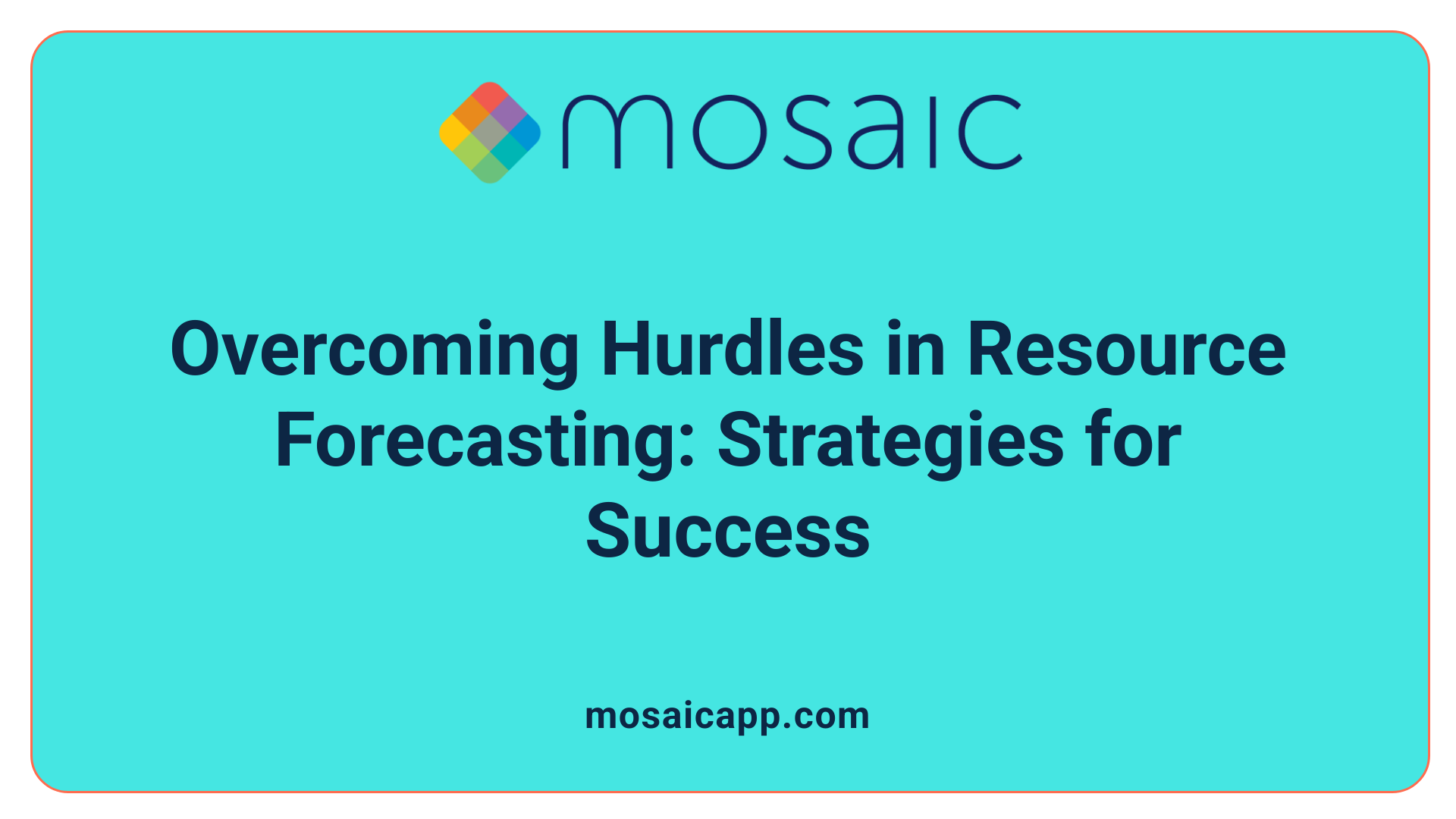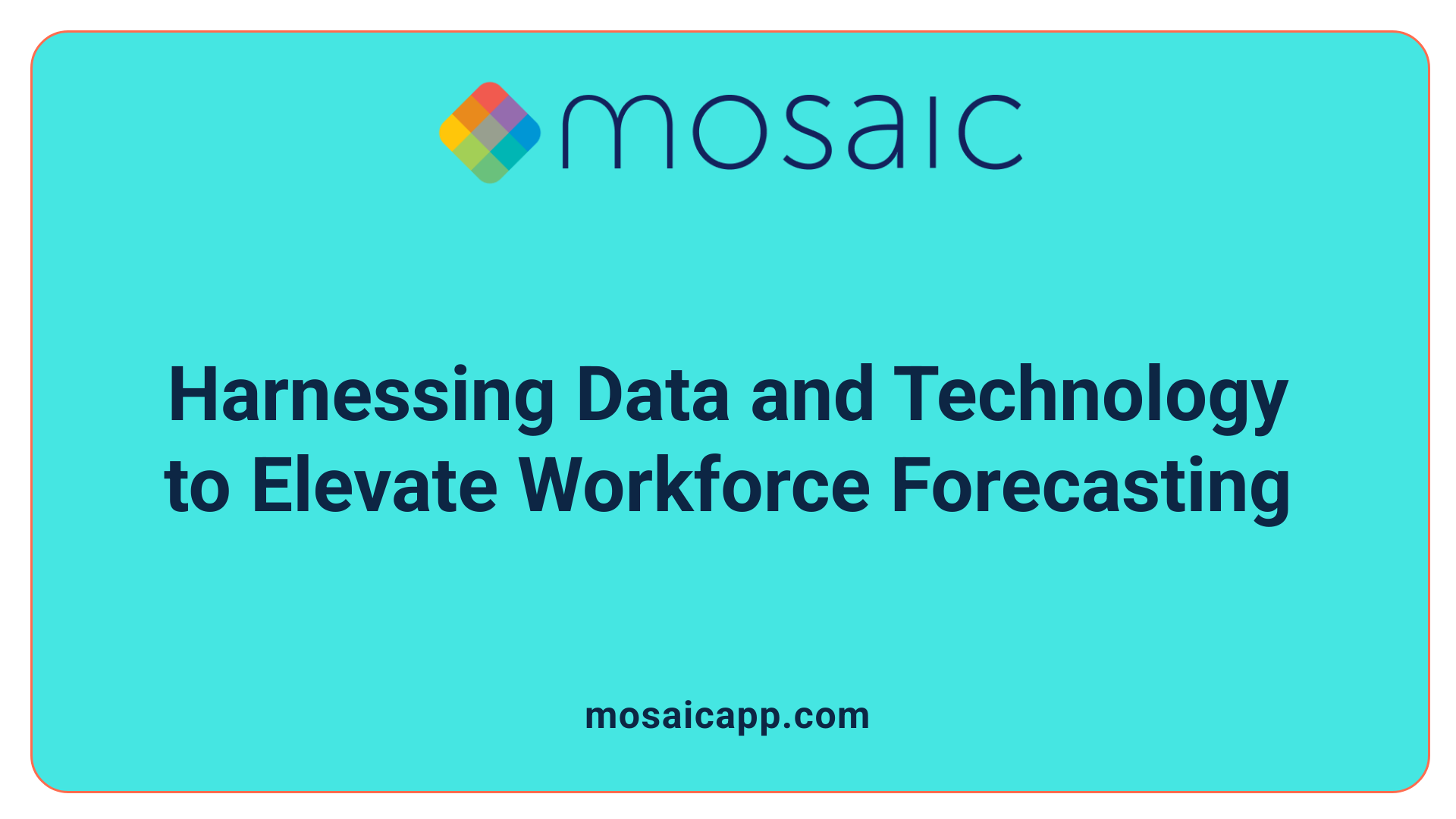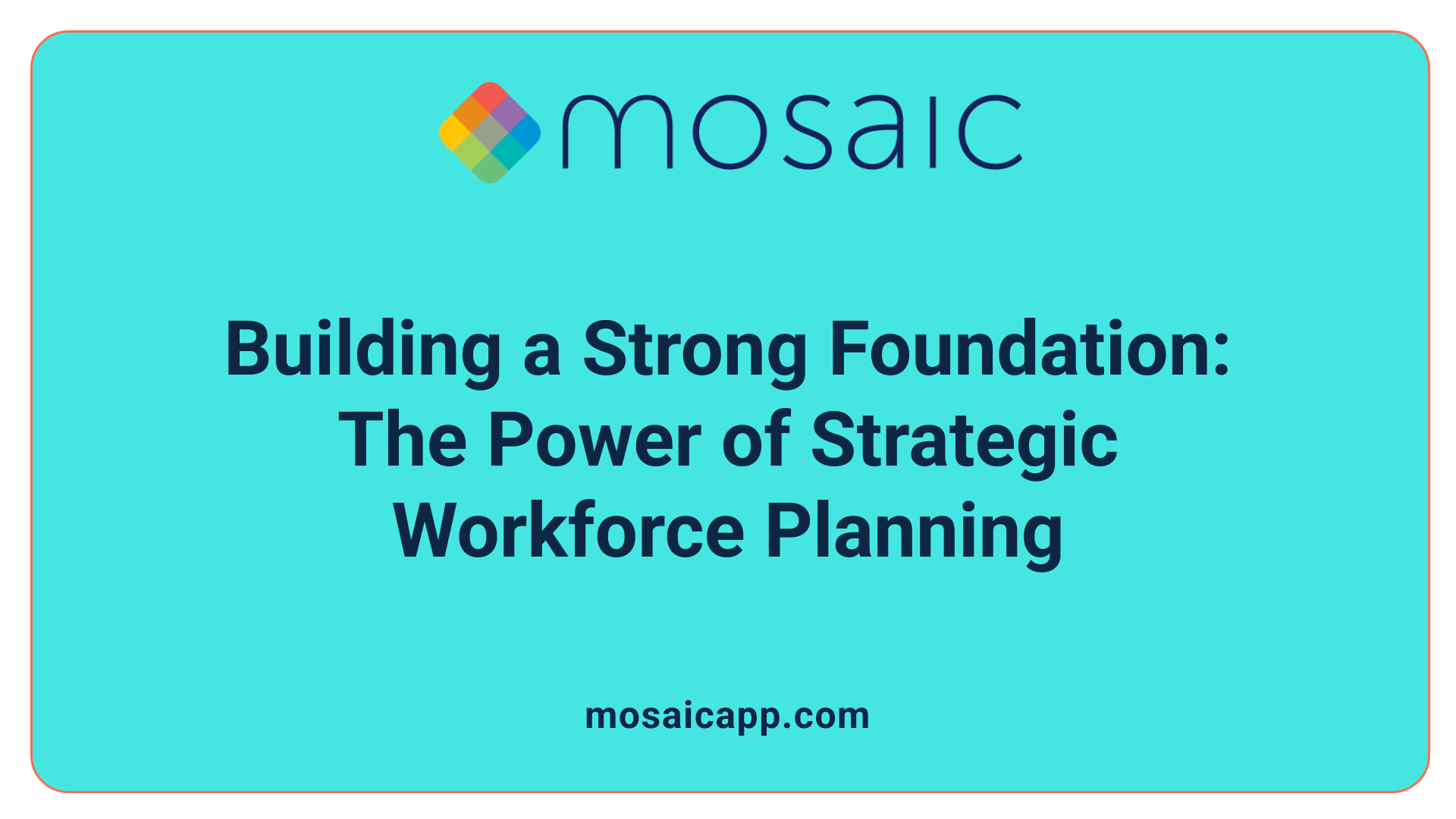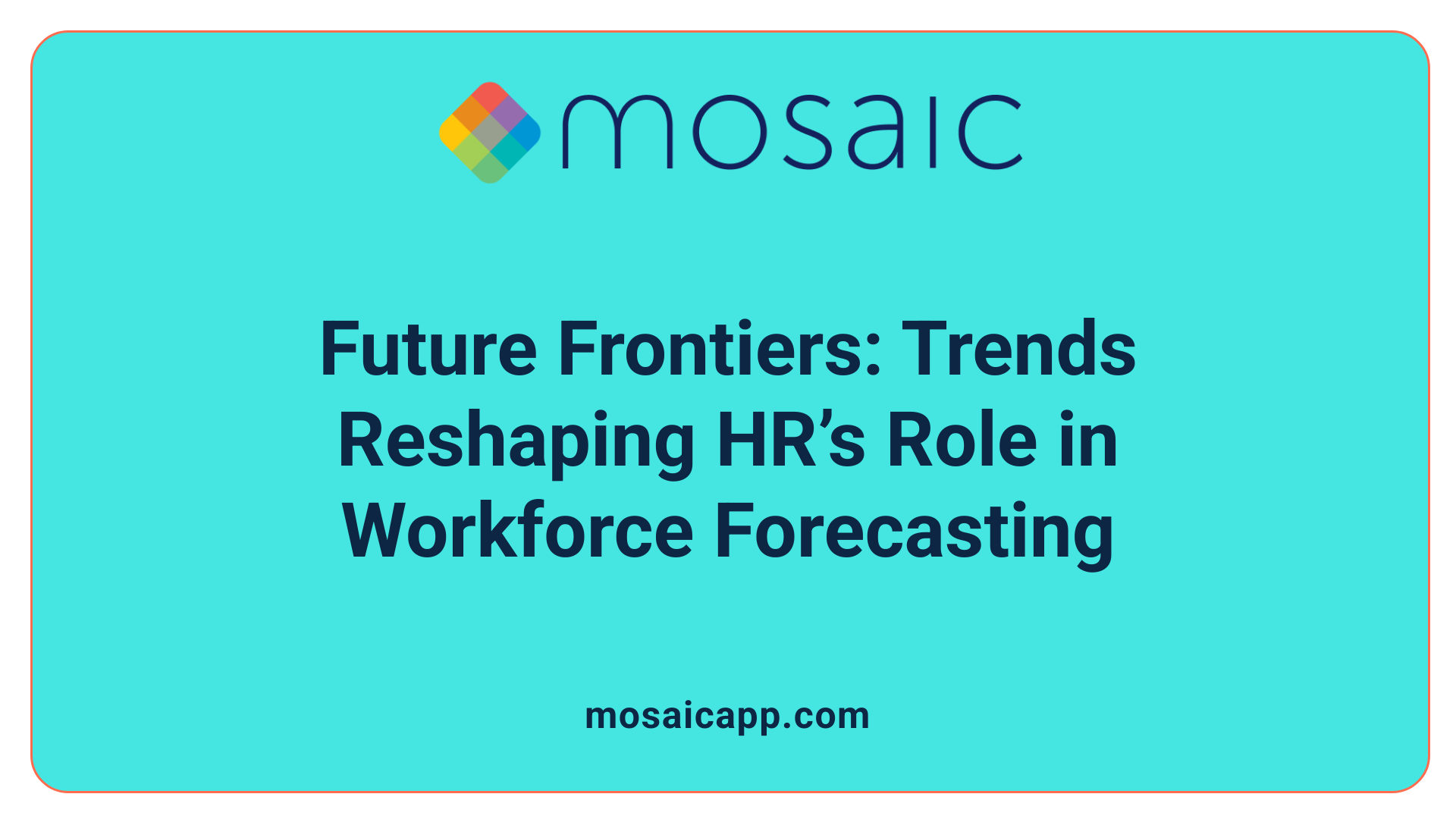The Crucial Intersection of HR and Forecasting
Organizations today face complex challenges in managing their human and technical resources amid dynamic market demands. Resource forecasting, a cornerstone of effective project management and strategic planning, requires the integration of diverse expertise. This article explores why HR leaders must be integral players in the forecasting process, linking workforce strategy directly to organizational growth, capability, and resilience.
Understanding Resource Forecasting and Its Importance in HR
What is resource forecasting and why is it critical in HR?
Resource forecasting involves predicting an organization's future needs for human capital, technology, and financial resources. In the HR context, this forecasting is vital because it ensures that the organization has the right talent and supporting resources available to execute business strategies effectively.
The role of resource forecasting within HR
Within Human Resources, resource forecasting helps optimize resource utilization by anticipating staffing requirements, technology needs, and budget allocations. This forward-looking approach allows HR teams to strategically plan recruitment, training, and development efforts, aligning workforce capabilities with anticipated business demands.
How resource forecasting links to organizational preparedness
Effective resource forecasting prepares organizations to handle future challenges by aligning resource availability with upcoming projects and shifts in market demand. By anticipating changes proactively, organizations improve their agility, reduce risks related to understaffing or over-allocation, and maintain continuous operational efficiency.
Types of resources forecasted
- Human Capital: Predicting staffing levels, skill sets, and workforce composition needed for future projects.
- Technology: Forecasting tools, software, and technological infrastructure required to support business initiatives.
- Financial Inputs: Estimating budgetary requirements to fund personnel, technology investments, and other operational needs.
Together, these resource forecasts help HR and leadership teams coordinate efforts to support the organization’s strategic objectives and growth plans.
Aligning Resource Forecasting with Business Strategy
How Workforce Planning Translates Business Objectives into Talent Requirements
Workforce planning serves as a bridge between business strategies and human capital needs. By analyzing business goals, HR can forecast the types and numbers of talent required to achieve these objectives. This process not only identifies skill sets needed for projects but also helps prioritize roles by segmenting jobs into strategic, core, and non-core categories, ensuring critical positions receive focused talent management.
Strategic Alignment Benefits
When resource forecasting is aligned with business strategy, organizations benefit in multiple ways. They can optimize resource capacity to support long-term growth, streamline project management, and reduce inefficiencies caused by misaligned staffing. Such alignment enhances organizational agility, as the workforce is prepared to meet evolving demands with the right skills at the right time.
Collaboration Between HR and Project Managers for Resource Requirements
Effective resource forecasting involves close collaboration between HR leaders and project managers. HR brings insights from workforce analytics and demand forecasting, while project managers provide detailed resource needs tied to specific initiatives. This participative approach promotes accuracy in forecasting and ensures resource plans truly reflect project realities and strategic priorities.
Impact on Organizational Growth and Project Success
By synchronizing resource forecasting with business strategy, organizations position themselves for successful project delivery and sustained growth. Adequate and well-aligned staffing reduces delays and bottlenecks, boosts employee satisfaction through stable employment, and enhances competitive advantage. Ultimately, this strategic integration supports more effective execution of business plans and long-term organizational success.
How does aligning forecasting with business strategy enhance organizational outcomes?
By linking resource forecasting to business goals, organizations ensure workforce capacity matches strategic objectives, facilitating project success, operational growth, and competitive advantage.
The Evolving Role of the CHRO in Forecasting Processes
What role do CHROs play in resource forecasting?
Chief Human Resources Officers (CHROs) have a pivotal role in resource forecasting by driving workforce strategy mapping and meticulous demand forecasting. They lead the development of comprehensive workforce strategies that align talent needs with organizational objectives, ensuring human capital supports both current and future projects.
Use of real-time data and professional services insights
CHROs leverage real-time data and insights from professional services to anticipate shifts in staffing demands accurately. By analyzing live workforce analytics, HR information systems, and labor market trends, CHROs can proactively adjust resource plans, addressing both immediate project needs and long-term capacity.
Collaboration with cross-functional leadership
Effective resource forecasting requires CHROs to work closely with project managers and other organizational leaders. This cross-functional collaboration enables a blend of strategic foresight and operational detail, improving the precision of forecasts. By engaging different departments, CHROs ensure workforce plans are well integrated with business goals, enhancing project execution and organizational agility.
Enhancing workforce planning credibility
Involving CHROs in forecasting enriches credibility and strengthens HR’s strategic influence. Their participation fosters trust in workforce planning processes and aids in identifying skill gaps, succession requirements, and talent development strategies. This comprehensive approach results in more accurate resource allocation and better preparation for future challenges, solidifying HR’s role as a business partner in capacity planning.
Challenges in Resource Forecasting and Overcoming Them

What challenges does resource forecasting face and how can organizations overcome them?
Resource forecasting faces several significant challenges that can impact its accuracy and effectiveness. One major issue is data limitations, where incomplete or outdated information hinders precise prediction of future needs. Additionally, rapid market changes and volatility complicate forecasting efforts, as shifting demands and external factors often disrupt initial plans.
Another challenge is conflicts in resource allocation. Different projects or departments may compete for limited personnel, technology, or financial resources, making it difficult to balance priorities effectively. Skills mismatches also pose problems, as the available workforce might not match the evolving requirements of new projects or technologies. Unforeseen events, such as sudden turnover or unexpected business changes, further complicate forecasting efforts.
To address these challenges, organizations adopt strategies centered around data-driven techniques that leverage real-time analytics and predictive tools. These help refine forecasts by incorporating the latest trends and workforce metrics. Enhancing communication across teams ensures alignment between HR, project managers, and leadership, allowing resource needs and constraints to be transparently discussed and managed.
Proactive scenario planning is another crucial approach. By simulating different future conditions, companies build flexibility into their resource plans, preparing for possible disruptions or opportunities. Continuous learning and adaptation enable organizations to refine their forecasting methods over time, improving resilience against uncertainty.
Together, these strategies enable more accurate and agile resource forecasting, supporting stronger alignment with organizational goals and better preparation for changing demands.
Data-Driven Tools and Technologies Enhancing Workforce Forecasting

How do technology and data tools improve workforce forecasting?
Advanced technological tools have significantly transformed workforce forecasting by boosting both accuracy and operational efficiency. HR analytics platforms and predictive analytics leverage historical and real-time data to generate insightful forecasts, helping organizations anticipate future talent needs and skill gaps more precisely.
Real-time dashboards and skills matching software provide up-to-the-minute visibility into employee capabilities and availability, enabling agile adjustments to resource allocation and project planning. These tools improve collaboration between HR and project managers by offering integrated profiles and workload reports.
The integration of AI and machine learning further elevates forecasting capability by automating trend analysis and scenario planning. AI-driven systems analyze complex variables such as market dynamics, internal turnover, and technological advances to make refined predictions. Machine learning models continuously learn from new data, allowing forecasts to adapt to unexpected changes swiftly.
Collectively, these data-driven approaches lead to enhanced strategic alignment and proactive workforce management. Organizations benefit from improved utilization of human capital, reduced talent shortages, and quicker responses to shifting demands. This level of precision in resource planning supports sustainable growth and competitive advantage.
| Technology Tool | Functionality | Benefits |
|---|---|---|
| HR Analytics Platforms | Analyze workforce data trends | Greater forecasting accuracy and insight |
| Predictive Analytics | Predict future staffing requirements | Early identification of gaps and needs |
| Real-Time Dashboards | Monitor skills and project allocation | Agile resource adjustments |
| Skills Matching Software | Match employee skills to job demands | Optimal utilization of talent |
| AI and Machine Learning | Automate scenario planning and forecasts | Enhanced adaptability and prediction accuracy |
Strategic Workforce Planning: The Foundation of Effective Forecasting

What constitutes effective strategic workforce planning in forecasting?
Effective strategic workforce planning involves a systematic, data-driven approach that aligns an organization's talent needs with its business objectives. It ensures the right people with the right skills are in the right place at the right time.
Systematic five-step HR planning process
- Evaluating the current workforce: Assessing workforce structure, capabilities, engagement levels, and retention using tools like HRIS data and employee surveys.
- Forecasting future needs: Employing techniques such as trend analysis, regression, and Delphi methods while considering technology and organizational changes.
- Gap analysis: Comparing current capabilities to future demands to identify skills shortages, succession gaps, and talent deficits.
- Developing and implementing HR plans: Setting clear objectives and strategies for recruitment, training, performance management, and employee engagement.
- Monitoring and reviewing progress: Tracking metrics such as turnover and hiring rates and updating plans to adapt to organizational shifts.
Evaluating current workforce and forecasting future needs
Analyzing internal factors like headcount, turnover rates, and retirement eligibility, combined with external labor market data, provides a foundation for accurate forecasting. This enables organizations to anticipate staffing requirements aligned with business growth and project demands.
Gap analysis of skills and talent shortages
This critical step identifies where the current workforce falls short relative to future needs. It highlights areas where talent development, recruitment, or succession planning should focus to ensure continuous operational excellence.
Developing, implementing, and monitoring HR plans
Formulating targeted HR strategies based on the identified gaps helps address recruitment, training, and employee engagement effectively. Continuous monitoring and adjustment ensure that the workforce remains agile and capable of meeting evolving business priorities.
By following this comprehensive process, organizations can proactively manage talent, reduce skill mismatches, and support sustained growth through well-informed resource forecasting.
The Power of Collaboration Between HR and Project Management
Why is collaboration between HR and project managers vital in forecasting?
Collaborative approaches to resource forecasting are essential because they blend strategic foresight with practical project realities. By involving both HR leaders and project managers, organizations can align high-level strategic goals with detailed, on-the-ground project needs. This alignment improves the accuracy of forecasting, ensuring that resources are allocated efficiently and effectively.
Participative forecasting approaches
Participative forecasting involves engaging stakeholders from multiple levels within an organization, particularly HR and project teams. This method combines top-down strategic planning with bottom-up inputs from those directly managing projects. It helps capture a comprehensive picture of resource demands, reflecting both future business directions and immediate project requirements.
Benefits of integrating top-down strategy with bottom-up project needs
The integration of strategic objectives and project-specific demands leads to several benefits:
- Improved forecasting accuracy: Gathering diverse insights enhances the precision of resource demand predictions.
- Reduced project delays: Timely availability of the right talent and resources avoids bottlenecks.
- Optimized resource utilization: Efficient distribution reduces excess or insufficient allocation.
- Proactive contingency planning: Anticipating possible disruptions allows for the development of risk management plans.
Case studies on reduced delays and improved resource utilization
Various organizations demonstrate that when HR collaborates closely with project managers, project outcomes improve significantly. Case studies reveal that integrating data analytics and scenario planning within this partnership reduces resource-related delays and improves utilization rates. These successes highlight the importance of continuous communication and adjustment in resource forecasting.
Developing risk management strategies
An integral part of collaboration is preparing for uncertainties. Organizations develop risk management plans and build buffers to account for potential employee turnover, skill mismatches, or unforeseen performance issues. Such strategies enable projects, especially in dynamic industries like creative sectors, to maintain momentum despite challenges.
Collaborative resource forecasting is a powerful means to enhance project success and organizational agility, leveraging the strengths of both HR and project management teams.
Enhancing Organizational Agility and Resilience Through HR Forecasting
How does HR-driven forecasting enhance organizational agility?
HR-driven forecasting enhances organizational agility by enabling companies to swiftly adapt to rapid market and internal changes. By continuously updating workforce plans based on real-time data, HR can anticipate shifts in talent needs and align staffing to meet emerging demands.
Proactive resource management includes developing buffer and risk plans to address inevitable turnover or performance fluctuations. These contingency strategies help maintain productivity and reduce disruption during staffing changes.
HR’s involvement in change management ensures smooth transitions during organizational restructuring, technology adoption, or strategic shifts. By coordinating workforce adjustments with clear communication and employee support, HR minimizes resistance and downtime.
Regularly revisiting and expanding workforce forecasts keeps the organization resilient amid evolving business conditions. This ongoing process supports operational stability and sustains growth objectives even in uncertain environments.
Forecasting for Talent Management: Development, Retention, and Succession
How does resource forecasting support talent management?
Resource forecasting plays a vital role in talent management by identifying skill gaps and talent deficits before they impact organizational performance. This foresight enables HR leaders to implement targeted training and development programs that align precisely with anticipated needs. By anticipating future workforce requirements, organizations can proactively prepare employees for upcoming roles or new skill sets, ensuring a continuous talent pipeline.
Identifying skill gaps and talent deficits
Through data analytics and scenario planning, forecasting reveals deficiencies between current employee capabilities and future demands. HR professionals analyze internal data such as skills inventories, turnover rates, and retirement eligibility. They also consider external labor market trends to predict where shortages may occur, allowing early intervention.
Implementing training and development aligned with forecasted needs
Once gaps are identified, workforce plans translate forecasts into actionable training and development strategies. Tailored programs help employees acquire necessary skills and competencies, directly addressing forecast-identified deficits. This alignment promotes efficient use of resources and enhances employee engagement by providing meaningful growth opportunities.
Succession planning for leadership continuity
Forecasting informs succession planning by highlighting potential shortfalls in leadership pipelines. HR collaborates with leadership teams to prepare for retirements or departures, ensuring smooth transitions and uninterrupted strategic execution. Succession efforts focus on developing high-potential talent ready to step into critical roles.
Retention strategies informed by workforce insights
Accurate forecasting enhances retention by identifying employees at risk of becoming overextended or misaligned with organizational goals. HR can then enact targeted strategies such as recognition, career development, or workload balancing to enhance job satisfaction and reduce turnover. By maintaining stability, organizations sustain project momentum and foster a positive culture.
In conclusion, resource forecasting supports comprehensive talent management by enabling organizations to anticipate and meet future staffing needs through development, retention, and thoughtful succession planning. This proactive approach ensures the right people with the right skills are always available to meet evolving business challenges.
Impact of Workforce Analytics on Performance and Culture
What is the role of workforce analytics in enhancing performance and culture?
Workforce analytics is crucial for providing data-driven insights into employee performance, engagement, diversity, and inclusion. By analyzing these factors, HR professionals can identify trends and gaps that influence how teams operate and how satisfied employees feel.
Using analytics to track performance, engagement, diversity, and inclusion
Analytics tools enable HR to monitor key metrics like employee productivity, turnover rates, engagement levels, and diversity statistics. These insights help pinpoint areas where performance may be lagging or where inclusivity efforts need strengthening.
Informing HR’s role in shaping organizational culture
With detailed workforce data, HR can craft strategies that promote a positive organizational culture. This includes fostering diversity and inclusion, enhancing employee satisfaction, and creating an environment that attracts and retains top talent.
Aligning workforce analytics with project and strategic goals
By connecting analytics outcomes to project needs and broader strategic objectives, HR ensures talent development and resource allocation support organizational growth effectively. Data insights help forecast skill gaps and guide targeted training and recruitment.
Benefits to employee satisfaction and organizational competitiveness
Effective use of workforce analytics leads to higher employee satisfaction through better engagement and tailored development opportunities. This, in turn, boosts organizational competitiveness by maintaining a skilled, motivated workforce aligned with business goals.
Future Trends Shaping HR’s Role at the Forecasting Table

What future trends will influence HR’s role in forecasting?
Emerging trends are transforming how HR contributes to resource forecasting, pivoting around technology, collaboration, and sustainability.
AI and Machine Learning Integration: HR is increasingly leveraging AI and machine learning algorithms to enhance prediction accuracy for workforce demand. These technologies analyze complex data patterns and provide real-time insights, helping HR anticipate staffing needs more precisely and optimize talent allocation.
Agile and Continuous Forecasting Processes: Traditional forecasting is evolving into dynamic, continuous models that enable organizations to quickly adjust resource plans in response to changing market conditions. HR adopts agile methodologies to maintain flexibility, ensuring workforce strategies stay aligned with real-time organizational goals.
Cross-Functional Collaboration Enhancements: Future HR forecasting emphasizes deeper integration with other departments, such as finance, operations, and project management. This collaborative approach aligns workforce capacity closely with business strategy and project requirements, improving the responsiveness and accuracy of resource planning.
Sustainability and Ethical Considerations: As organizations prioritize sustainable growth, HR forecasting incorporates environmental and social governance factors. Resource plans now reflect not only business needs but also ethical labor practices, diversity, inclusion, and corporate responsibility, fostering long-term organizational resilience.
These trends are collectively redefining HR's strategic role, empowering HR leaders to guide workforce planning with innovative tools and a holistic perspective that fosters sustainable competitive advantage.
Measuring Success and Ensuring Continuous Improvement in Workforce Forecasting
How can organizations measure success and improve workforce forecasting?
Organizations can gauge the effectiveness of their workforce forecasting by tracking key performance metrics such as employee turnover rates, hiring rates, and resource utilization. These indicators provide insights into how well staffing aligns with organizational needs, helping to identify talent gaps and opportunities for optimization.
Regular reviews and adjustments to workforce forecasts are essential to maintain alignment with changing business conditions and market dynamics. By continuously analyzing new data, organizations can adapt their plans to unforeseen events, technological shifts, or evolving project demands.
Engaging stakeholders from various departments—including HR professionals, project managers, and senior leadership—in the forecasting process ensures comprehensive alignment with business goals. Collaborative input enriches accuracy, promotes transparency, and drives collective ownership of resource planning outcomes.
Case studies highlight measurable benefits when HR is deeply involved in resource forecasting. For example, organizations that integrate HR analytics with scenario planning often experience reduced project delays, improved talent utilization, and enhanced strategic capacity planning.
Through ongoing monitoring of workforce metrics, collaborative forecast refinement, and learning from successful practices, organizations can enhance the accuracy, relevance, and strategic value of their workforce forecasting efforts.
Empowering HR Leadership to Drive Strategic Forecasting
The integration of HR leaders into the forecasting process is no longer optional—it's a strategic imperative. Their unique insight into talent dynamics, combined with data-driven tools and collaborative approaches, elevates resource forecasting from a tactical function to a driver of organizational agility and growth. By embracing this expanded role, HR can directly influence project success, operational efficiency, and long-term competitiveness, ensuring organizations not only meet current demands but also confidently navigate future challenges.
References
- Mastering the Art of Resource Forecasting in HR Leadership -
- Putting Forecasting in Focus
- Human Resource Planning Process: The Complete Guide
- HR's Role in Strategic Planning Article
- Why Resource Forecasting in Project Management is ...
- Workforce Forecasting: Definition, Benefits, How-Tos, and ...
- Strategic Planning for HR Managers
- What Are The Benefits Of Human Resource Planning?


